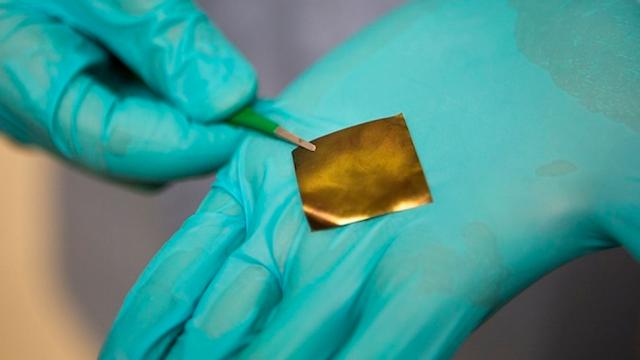Have you ever thought about the possibilities of bendable, stretchable electronics? They’re amazing. From a circuit attached to your brain to a pacemaker that sticks to your, these are the stuff that medical sci fi dreams are made of. There’s only one problem: stretchable electronics are notoriously impossible to make — until now.
A team of engineers from the University of Michigan are currently perfecting an unassuming but incredible invention. It’s an elastic gold conductor. Made up of gold nanoparticles and stretchy polyurethane, the material just looks like a piece of foil to the naked eye. But after watching it stretch out four times its normal size, it’s obvious that this conductor is something else. “It looks like elastic gold,” says Nicholas Kotov, one of the chemical engineer who created the material. “But we can stretch it just like a rubber band.”
This is a big feat. The problem with developing stretchable conductors is that the two characteristics, in the words of the Michigan team, are “fundamentally difficult properties to combine”. Stretching a conductive material makes it less conductive, and stretchy materials tend not to be very conductive in the first place. This is because as a material stretches, the molecules rearrange themselves, and the electrons are spaced further apart. In the past, the best way to make stretchable electronics was to bend or coil up conductive wires so that when they stretch, the circuits just unfold. With the new method, however, the material can be stretched to four times its size while still holding onto its conductive abilities.
Now that we’ve got this amazing new material, a number of amazing uses for it come to mind, mainly in the world of medical technology. The stretchable gold could be applied directly to the surface of the brain to help people suffering from all kinds of injuries and ailments, because when connected to a power source, the material could deliver tiny jolts of electricity to specific areas. In fact, Kotov and team are already looking at performing experiments on rat brains as a next step in their research.
The foil could likewise be implanted directly onto the heart where it could act as a stretchable, low impact pacemaker or otherwise regulate heart functioning. It could be also be incorporated into a catheter system that could be inserted into an artery near the heart and transmit information about heart performance back to an external device. In the simplest of ways, it could be applied to the skin to monitor a whole host of variables including not only heart rate but also blood oxygenation, respiration, perspiration and so forth. Less sophisticated stretchable electronics could be used for anything from monitoring sleep and fitness keeping an eye on your hydration levels.
If this all sounds very futuristic that’s because it is. It also goes to show how small breakthroughs in engineering can lead to major advances in the real world, especially the medical world. Of course, considering the stretchable conductor is made of gold, these advances won’t be cheap. [Nature via Wired]
Picture: Michigan Engineering
